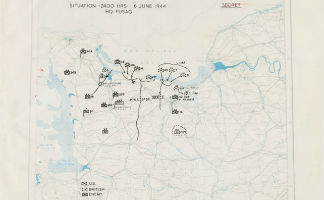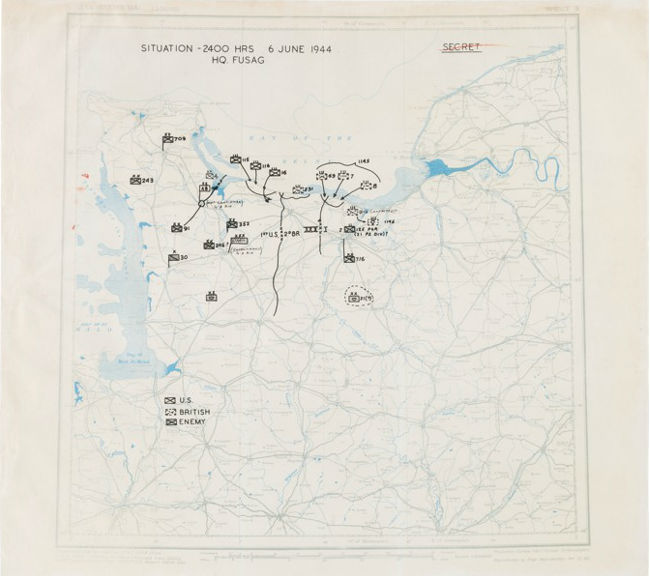
DALLAS – Three battle maps owned and used by Gen. Omar Bradley from the June 6, 1944 Allied invasion of occupied France at Normandy are expected to be among the most coveted lots at Heritage Auctions’ Arms & Armor Auction June 11. Absentee and Internet bidding is available through LiveAuctioneers.
The largest seaborne invasion in history, the assault included 156,000 American, British and Canadian forces landing on five beaches along 50 heavily fortified miles of French coastline. The day known as D-Day is recognized as the start of the Allies’ liberation of Western Europe from Nazi Germany’s control.
Omar Bradley’s D-Day map for Operations Overlord and Neptune (est. $70,000 and up) was used by Bradley during the invasion at Normandy. Titled “Situation – 2400 Hrs 6 June 1944 Hq. Fusag [First United States Army Group] Secret,” the map measures 20 inches high by 22-1/2 inches wide, and is printed with blue and black ink.
Another of Gen. Bradley’s D-Day maps (est. $40,000 and up) is similar in many ways, although the “Secret” designation was downgraded to “Confidential.” This map shows the position of American, British and German forces on the first full day of the Allied invasion that led to the defeat of Adolph Hitler and the subsequent liberation of Europe.
A third Gen. Bradley D-Day map (est. $40,000 and up) has the same measurements and also carries the “Secret” designation. Like the first two, this map was produced by the 12th Army Group Engineering Department. It notes the location of German tanks, both inland and along the lines of defense, and shows higher troop concentration than that shown on the previous day’s map, as both sides dedicated extensive resources to the struggle that altered the course of the war. The three maps included in the Arms & Armor Auction were part of a set Gen. Bradley used in his capacity as commander of all U.S. ground forces in the invasion.
A battle-scarred U.S. flag that flew from the LCT 540 (est. $40,000 and up) was consigned by Ensign (later Lieutenant) William L. Wilhoit. The professionally framed flag measures 36 inches long and is folded and mounted to a red velvet background with a metal plaque with an inscription that reads: “Flag of the US LCT 540/Normandy Invasion/June 6, 1944.” The flag is accompanied by a letter of authenticity signed by Wilhoit dated June 16, 2016 and copies of the Presidential Unit Citation to United States LCT (landing craft, tank) 540 signed by Secretary of the Navy James Forrestal and a Navy Cross Citation to “Ensign William L. Wilhoit United States Naval Reserve” that also was signed by Forrestal.
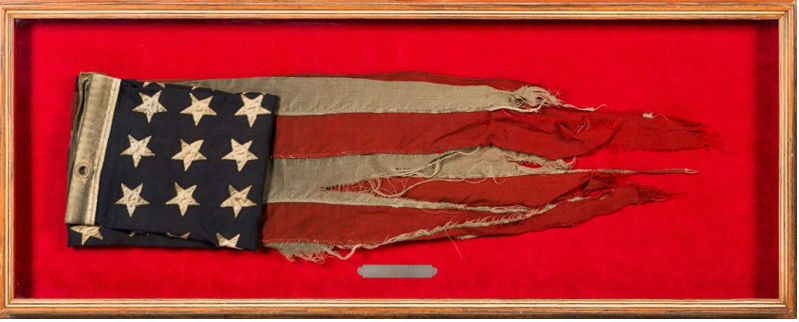
A blood-stained flag from the Battle of Antietam (below; est. $30,000 and up) measures 77 inches wide by 46 inches high and features a canton with 34 stars and is housed in a frame that measures 85 inches wide by 53 inches high. According to family lore, after the Battle of Antietam (Maryland), Gen. George B. McClellan and his troops were riding down a street in Sharpsburg when he directed that the flag be given to a local resident with the message that “Here is something to remember us by.” The flag remained in the recipient’s family for more than 90 years before being given to the consignor’s father, and was loaned to the Sharpsburg Museum in 1962 for the 100th anniversary of the Battle of Antietam. The flag, which is sewn on to a burlap backing and sealed against moisture, has 17 bullet holes and significant blood staining, mostly near the canvas hoist.
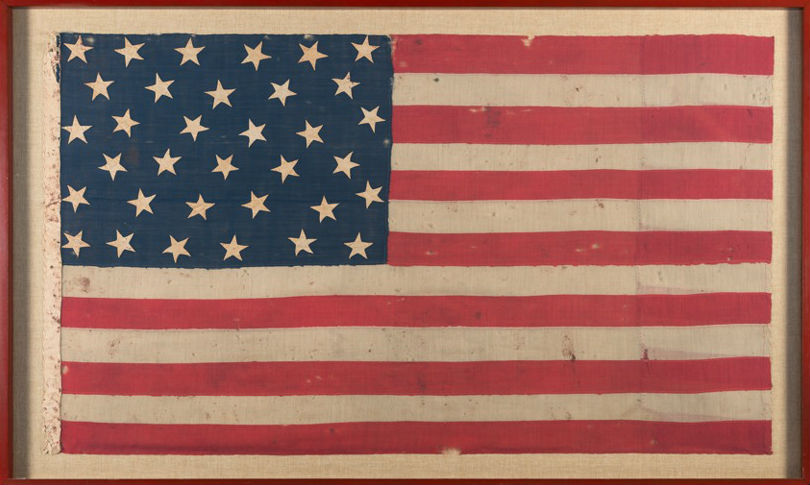
A set of Confederate artillery implements and Augusta fuse box (est. $24,000 and up) is marked, “Darrow Augusta, Ga.” in an oval stamp on the flap. The group includes a finely crafted lanyard that was used to set off the cannon blast; a Confederate-manufactured friction primer that was used to spark the cannon’s ignition; a vent pouch that would have cleaned out the fuse hole of the cannon; three shell fuses, two of which are wrapped; and a long steel cylinder with brass ends that was used to hold the bursting charge for an Armstrong cannon. Also included is a copy of the 2005 No. 2 edition of North South Trader magazine, which featured the implements and Augusta box on the front cover of that issue and an article detailing the pieces and showing images of the factory that manufactured the box.
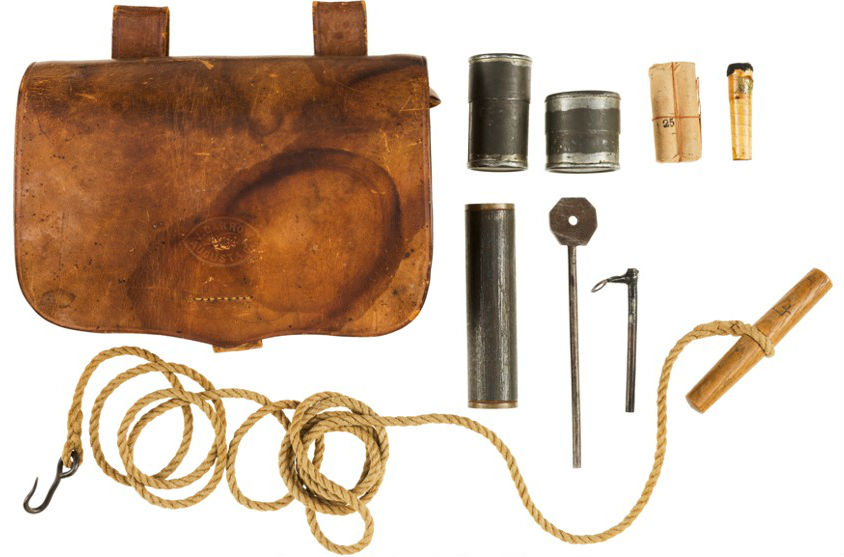
A Confederate First National Flag reportedly captured from the Biloxi Courthouse in 1861 (est. $20,000 and up) measures 75 3/4 inches wide and 37 inches high; its frame increases the dimensions to 82-by-44. A 13-star variant of the First National Flag of the Confederate States of America, it reportedly was accompanied at one time by a now-lost label that said the flag was found in an old coffee can inside the vault of the Hancock County Courthouse that was being demolished to make way for construction of a new facility. The label said the flag flew on the Biloxi, Mississippi Courthouse and that was “captured by vile, Yankee, invading forces during the capture of Biloxi. The flag eventually was returned to the Biloxi-based Mississippi Division of the Sons of Confederate Veterans, and its size and use of the 13-star design is consistent with a dating of 1861, when neighboring states Missouri and Kentucky were on the verge of secession.
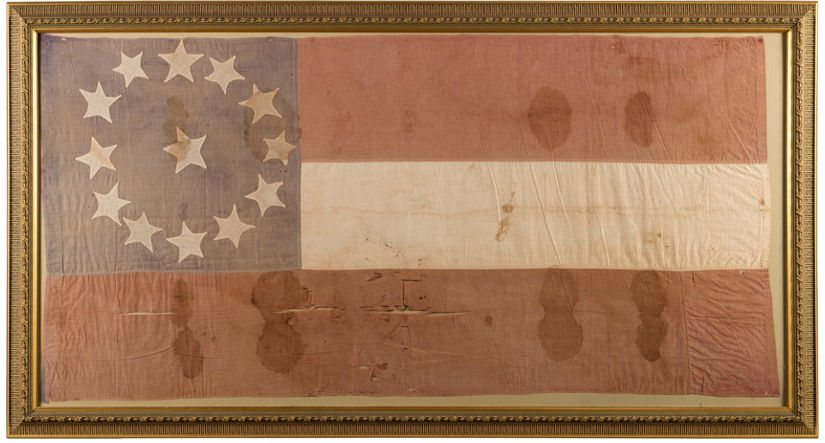
One of the unique lots in the auction is an original German navy (Kriegsmarine) Four-Rotor M4 Enigma enciphering machine recovered from the wreck of the German submarine tender Ammerland (est. $20,000 and up). One of what might be as few as 120 surviving examples, this Enigma machine was used in Germany during World War II to transmit coded information after the realization that Western Allies were intercepting German Navy signals, and is credited with playing a significant role in the development of modern computing. Because of the rarity of remaining machines, examples in any condition rarely find their way to the collector market; some that have gone to auction recently have realized sale prices between $150,000 and $300,000. This M4 example was recovered by Swedish divers from the wreck of the German submarine tender Ammerland, circa 1990. The Ammerland was attached to Sicherungsflottille 9 in the Baltic Sea when it was sunk Feb. 10, 1945. After being submerged for about 45 years, it is preserved in distilled water until it can be properly restored.
[av_button label=’View the fully illustrated catalog and bid in LiveAuctioneers.’ link=’manually,http://bit.ly/2qU00Eb’ link_target=’_blank’ size=’medium’ position=’center’ icon_select=’no’ icon=’ue800′ font=’entypo-fontello’ color=’theme-color’ custom_bg=’#444444′ custom_font=’#ffffff’ admin_preview_bg=” av_uid=’av-lzh7ko’]


